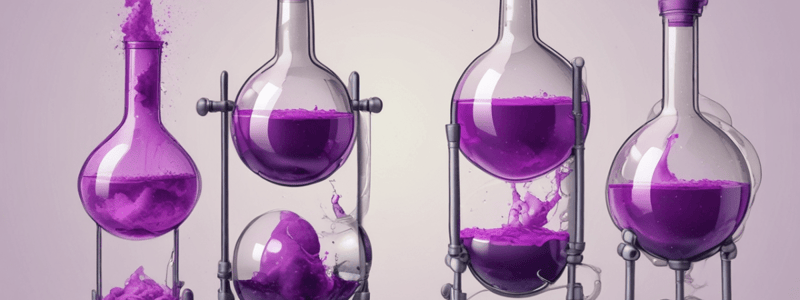Podcast
Questions and Answers
Why is excess potassium iodide used in the preparation of iodine solution?
Why is excess potassium iodide used in the preparation of iodine solution?
- To act as a solvent to keep the iodine in solution (correct)
- To ensure all of the I₂ from the KIO₃ solution reacts with thiosulphate (correct)
- To dilute the potassium iodate solution
- To react with thiosulphate directly
What is the purpose of adding starch indicator in the titration reaction?
What is the purpose of adding starch indicator in the titration reaction?
- To indicate the end-point of the titration (correct)
- To change the colour of the solution
- To react with the iodine solution
- To react with the thiosulphate solution
What is the application of iodine-thiosulphate reactions in the Winkler method?
What is the application of iodine-thiosulphate reactions in the Winkler method?
- To prepare iodine solutions
- To titrate thiosulphate solutions
- To determine the percentage of hypochlorite in bleach
- To find the amount of dissolved oxygen in water (correct)
Why is the bleach diluted before titration?
Why is the bleach diluted before titration?
What is the role of chlorine in the reaction with potassium iodide?
What is the role of chlorine in the reaction with potassium iodide?
What is the primary function of potassium permanganate in redox titrations?
What is the primary function of potassium permanganate in redox titrations?
What is the purpose of adding dilute sulphuric acid to the solution of ammonium iron (II) sulfate?
What is the purpose of adding dilute sulphuric acid to the solution of ammonium iron (II) sulfate?
Why is potassium permanganate not used with hydrochloric acid in redox titrations?
Why is potassium permanganate not used with hydrochloric acid in redox titrations?
What is the oxidation state of manganese in potassium permanganate?
What is the oxidation state of manganese in potassium permanganate?
What is the colour of potassium permanganate in its +7 oxidation state?
What is the colour of potassium permanganate in its +7 oxidation state?
What is the purpose of adding dilute H₂SO₄ to the iron tablets during the experiment?
What is the purpose of adding dilute H₂SO₄ to the iron tablets during the experiment?
Why is it necessary to prepare a fresh solution of Potassium permanganate just before titrating?
Why is it necessary to prepare a fresh solution of Potassium permanganate just before titrating?
In the titration of potassium permanganate with iron solution, what is the end-point of the reaction?
In the titration of potassium permanganate with iron solution, what is the end-point of the reaction?
What is the purpose of rinsing the burette with KMnO₄ solution before titration?
What is the purpose of rinsing the burette with KMnO₄ solution before titration?
What is the concentration of the iron solution in moles per litre if 25 cm³ of the solution requires 5.75 cm³ of a 0.015M KMnO₄ solution for a complete reaction?
What is the concentration of the iron solution in moles per litre if 25 cm³ of the solution requires 5.75 cm³ of a 0.015M KMnO₄ solution for a complete reaction?
Study Notes
Potassium Permanganate in Redox Titrations
- Potassium permanganate (KMnO₄) is a useful oxidizing agent in redox titrations due to its complete reaction and ability to act as its own indicator, showing a clear color change.
- However, it has disadvantages, such as being unstable and requiring standardization against a standard solution of ammonium iron (II) sulfate prior to titration.
Preparing Ammonium Iron (II) Sulfate Solution
- Ammonium iron (II) sulfate is a primary standard that can be weighed and diluted to make a standard solution.
- Dilute sulfuric acid is added to prevent the iron (II) in the solution from reacting with air to form iron (III).
- The solution is prepared by washing the powder into a beaker of dilute sulfuric acid, stirring well, and then transferring it to a volumetric flask.
Potassium Permanganate Solution
- Potassium permanganate contains Mn in the +7 oxidation state, which is purple in color.
- In acidic conditions, Mn is reduced completely, and no indicators are needed for the titration.
- However, if acidic conditions are not maintained, an intermediate oxidation state will be reached, resulting in a brown color.
- To prevent this, dilute sulfuric acid is added to the KMnO₄ solution.
Titration of Potassium Permanganate with Ammonium Iron (II) Sulfate
- The conical flask contains 25 ml of iron solution and 10 ml of dilute sulfuric acid.
- Prior to titration, the following washings should be carried out: washing the pipette, burette, and conical flask with DI water, rinsing the burette with KMnO₄, and rinsing the pipette with iron (II) solution.
- The end-point is reached when a pale pink color persists.
- The concentration of the potassium permanganate solution can be calculated using the volume of KMnO₄ required for a complete reaction with the ammonium iron (II) sulfate solution.
Potassium Permanganate vs. Ammonium Iron (II) Titration
- The reaction between potassium permanganate and ammonium iron (II) sulfate occurs in a 1:5 ratio.
- The concentration of the potassium permanganate solution can be calculated using the volume of KMnO₄ required for a complete reaction with the ammonium iron (II) sulfate solution.
Potassium Permanganate vs. Iron Tablet Titration
- A standardized solution of potassium permanganate can be used to determine the amount of iron in an iron tablet.
- The KMnO₄ solution must be standardized immediately before the titration since it is unstable.
- The iron tablets are ground up and dissolved in dilute sulfuric acid, and the solution is transferred to a volumetric flask.
- The concentration of the iron solution can be calculated using the volume of KMnO₄ required for a complete reaction with the iron solution.
Iodine vs. Thiosulphate Titration
- This is a redox titration that occurs between iodine and thiosulphate.
- The reaction is used to standardize the thiosulphate solution using a known concentration of iodine.
- DI water must be used during the experiment as tap water contains chloride ions that would displace iodine from iodine solutions.
- The iodine solution is prepared by adding potassium iodate, excess dilute sulfuric acid, and excess potassium iodide to water.
- The colour changes during the reaction are: red/brown prior to titration, pale yellow during titration, and colourless at the end-point.
Application of Iodine-Thiosulphate Reactions
- These titrations can be used to:
- Find the amount of dissolved oxygen in water (Winkler method).
- Determine the % hypochlorite in bleach.
Determining % Hypochlorite in Bleach
- The hypochlorite ion (OCl⁻) is the active ingredient in bleaches.
- Household bleach is very concentrated and must be diluted prior to titration.
- The diluted bleach is reacted with excess potassium iodide (KI) in the presence of acid, and the liberated iodine is titrated against a known thiosulphate solution.
- The same colour changes occur as before.
- The concentration of sodium hypochlorite in bleach and the % w/v of hypochlorite in bleach can be calculated using the volume of thiosulphate required for a complete reaction with the iodine solution.
Studying That Suits You
Use AI to generate personalized quizzes and flashcards to suit your learning preferences.
Description
Learn about the use of potassium permanganate in redox titrations, its advantages and disadvantages, and how to prepare ammonium iron (II) sulfate solution as a primary standard.




